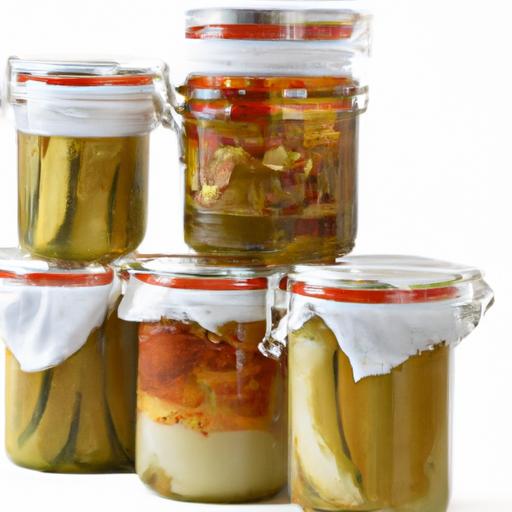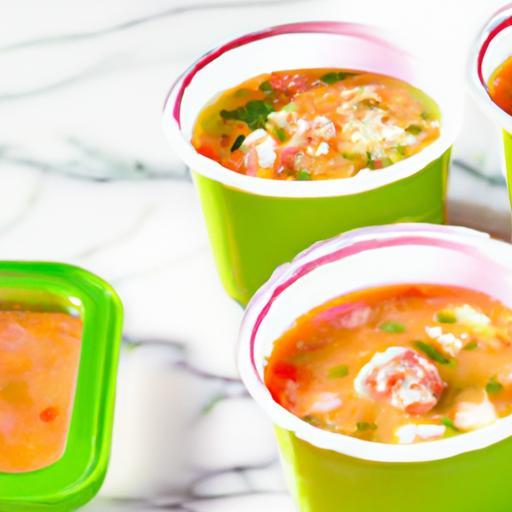Fermented foods are culinary treasures-bursting with bold flavors, rich textures, and a probiotic punch that elevates both taste and health. Yet, their magic only lasts if they’re stored just right. From tangy kimchi to creamy yogurt and bubbly kombucha, knowing how to keep these living foods fresh can transform your kitchen experience. In this article, we dive into savvy, science-backed tips to preserve the vibrant life in your fermented favorites, ensuring every bite stays crisp, flavorful, and beneficial. Ready to master the art of fermentation storage? Let’s unlock the secrets to keeping it fresh!
Keep It Fresh: Smart Tips for Storing Fermented Foods Right
Fermentation is a beautiful dance of science and tradition, transforming simple ingredients into vibrant, flavor-packed treasures. Keep It Fresh: Smart Tips for Storing Fermented Foods Right reveals how to maximize the longevity and zing of your homemade ferments. Whether you’re working with tangy sauerkraut or bubbling kimchi, understanding the delicate balance of fermentation processes and storage methods will elevate your culinary creations and preserve their lively character.
Prep and Cook Time
Preparation: 15 minutes (plus fermentation time)
Cooking/Storage Time: 1-4 weeks (depending on ferment)
Yield
Approximately 1 quart of fully fermented food per batch
Difficulty Level
Medium – requires attentive daily maintenance and precise storage conditions
Ingredients
- 1 medium head of cabbage, finely shredded
- 1 tablespoon sea salt
- Filtered water (chlorine-free), as needed
- Optional spices (caraway seeds, garlic cloves, ginger slices)
Instructions
- Prepare the cabbage: Massage salt into shredded cabbage until it softens and releases liquid, about 5-7 minutes.
- Pack tightly into fermentation jar: Use a sterile glass jar or ceramic crock, pressing down firmly to eliminate air pockets.
- Submerge the cabbage: Add filtered water if necessary, ensuring the cabbage remains fully submerged beneath the brine to prevent mold.
- Seal and ferment: Cover with an airlock lid or cloth to allow gases to escape but keep contaminants out.
- Store optimally: Place in a cool area (65-72°F) with stable humidity for 3-7 days, tasting daily for desired sourness.
- Transfer to cold storage: Once fermenting peaks, move to refrigerator or cellar (38-50°F) to slow fermentation and preserve freshness.
Understanding the Science Behind Fermentation and Storage
Fermentation is a living process governed by friendly microbes converting natural sugars into acids and probiotics. Mastering the environment-oxygen levels, container choice, temperature, and humidity-ensures these microbes thrive without spoiling your batch. By selecting containers that allow gases to escape yet prevent harmful bacteria or molds from invading, you create the perfect micro-ecosystem.
Selecting the Ideal Containers for Longevity and Flavor Preservation
Glass jars with airtight, but vented lids are best for preserving the complex flavors and preventing oxidation. Avoid plastic containers that can leach flavors or harbor unwanted bacteria. Ceramic crocks offer superior heat insulation and traditional appeal, sustaining consistent fermentation temperatures. Choose containers with wide mouths for easy packing and daily maintenance.
Temperature and Humidity Tips to Extend Freshness
Keep your ferments where temperatures stay steady between 65°F and 72°F during active fermentation. High humidity (70-80%) slows water evaporation and preserves texture. Once fermentation progresses to your liking, switch storage to cooler zones like a cellar or refrigerator at 38-50°F to halt fermentation, retain crunch, and extend shelf life.
Daily Maintenance Habits That Keep Fermented Foods Vibrant
Regularly check that vegetables remain submerged under brine to avoid spoilage. Skim any foam or scum gently using a clean utensil. Taste often to monitor development of tangy notes and to identify the perfect moment to refrigerate. Stir gently if fermenting in jars with cloth covers to redistribute microbes and flavors evenly.
Chef’s Notes
- Variation: Try different vegetables like carrots, radishes, or cucumbers for unique flavors.
- Substitution: Use pink Himalayan salt or kosher salt instead of sea salt to avoid anti-caking agents.
- Troubleshooting: Cloudy brine is normal; slimy textures or off smells indicate spoilage and require discarding.
- Make-Ahead: Prepare large batches and store smaller portions in separate jars for ease and freshness.
Serving Suggestions
Serve your fermented foods chilled alongside robust cheeses, cured meats, or inside sandwiches for a zesty crunch. Garnish with fresh herbs like dill or cilantro. Incorporate fermented veggies into grain bowls or toss into salads for depth and probiotic benefits.
| Nutrient | Per 100g |
|---|---|
| Calories | 20 kcal |
| Protein | 1.2 g |
| Carbohydrates | 4 g |
| Fat | 0.1 g |

For more insights on fermentation techniques, check our Complete Guide to Fermentation Techniques. To dive deeper into the science of fermentation, visit Science Daily’s fermentation research overview.
Q&A
Q&A: Keep It Fresh – Smart Tips for Storing Fermented Foods Right
Q1: Why is proper storage so important for fermented foods?
A1: Fermented foods are living ecosystems teeming with beneficial bacteria and yeasts. Proper storage ensures these microbes stay happy and active without turning your tangy kimchi into an overwhelming science experiment gone wrong. It preserves flavor, texture, and nutritional value, keeping your gut-friendly snacks fresh and safe.
Q2: Can fermented foods be stored at room temperature?
A2: Some fermented foods start their magic at room temperature – think sauerkraut bubbling on your countertop. But once they’ve reached that delightful tang, chilling is key. Refrigeration slows fermentation, preventing overripening and spoilage, and keeps that perfect balance of sour and crunchy intact.
Q3: What’s the ideal container for storing fermented goodies?
A3: Air-tight glass jars are the champions of fermented food storage. They keep oxygen and contaminants out while letting you spy on the fizzy action inside. Avoid metal containers unless they’re food-grade stainless steel, since reactive metals can alter flavor or leach unwanted compounds.
Q4: How do you prevent mold or spoilage while storing fermented foods?
A4: Keep your jars sealed but allow some breathable exchange if needed-like using fermentation lids with airlocks. Always use clean utensils to avoid introducing mold spores, and ensure the food stays submerged in brine or liquid to keep harmful bacteria at bay. A cozy, cool environment is your secret weapon.
Q5: Should you trust the “smell test” before eating stored fermented food?
A5: Your nose is a reliable ally. Pleasantly sour, slightly yeasty aromas mean your fermented treat is thriving. If you encounter off-putting smells-think rotten, cheesy, or ammonia-like-proceed with caution. When in doubt, throw it out; better safe than sorry!
Q6: How long can fermented foods be stored in the fridge without losing quality?
A6: Most fermented foods happily live 3 to 6 months under refrigeration, sometimes longer. Over time, flavors may deepen and textures soften, but the probiotics usually remain potent. Always check visual and sensory clues to know if your batch is still a probiotic powerhouse.
Q7: Can you refreeze fermented foods after storing them in the fridge?
A7: Freezing is generally not recommended because it can disrupt the microbial community and texture, turning your crunchy pickles into mushy shadows. However, if freezing is needed, opt for brief periods and thaw gently in the fridge.
Q8: Any quick hacks to keep fermented foods fresher longer?
A8: Absolutely! Store jars away from light to protect sensitive microbes. Top off with fresh brine if it evaporates. And try layering cabbage leaves or a plastic weight to keep everything submerged. These small moves make a big difference in freshness.
Keep your fermented treasures crisp, tangy, and alive by storing them smartly – your taste buds and your gut microbiome will thank you!
In Summary
In the vibrant world of fermented foods, proper storage is the unsung hero that keeps those tangy flavors alive and your gut happy. By embracing smart storage techniques-whether it’s choosing the right container, minding the temperature, or giving your jars a little extra TLC-you’re not just preserving food; you’re nurturing a living tradition. So go ahead, keep it fresh, keep it flavorful, and let your fermented creations continue to thrive, one bite at a time. Here’s to savoring every probiotic-packed spoonful with confidence and care!








